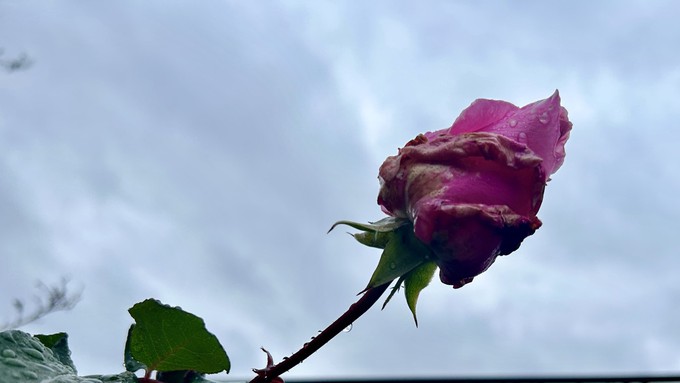
Rain and frost fill Sacramento’s forecast

A McCartney rose bud, doused with raindrops and showing signs of botrytis, is silhouetted against Saturday's rain clouds. The time to prune roses is now -- but preferably not in the rain. Kathy Morrison
Keep your umbrellas and frost cloths handy. Winter has finally arrived.
Rain (albeit light) and frost fill this week’s forecast, according to the National Weather Service. Unlike December’s relatively warm storms, these systems are coming from Alaska – and mighty chilly.
After Saturday’s showers, more rain is expected Tuesday, Wednesday, Thursday and Friday. But these storms will be hit or miss in the valley; as of Saturday (Jan. 6), the weather service predicts a total of only 0.47 inches for downtown Sacramento for the whole week.
Meanwhile, overnight lows are expected to dip into the 30s almost every night. Frost warnings will be in effect for Sunday and Monday mornings. Be prepared and protect plants before the sun goes down.
Saturday’s rain will help protect frost-sensitive plants, too. Moist soil tends to keep the surrounding air (and plant roots) up to five degrees warmer – just enough to avoid damage.
Daytime temperatures will be on the cool side, too. Tuesday will be our warmest afternoon, topping out at 53 degrees, says the weather service.
Concentrate on getting outdoor chores out of the way on Sunday and Monday, then settle in with some indoor gardening activities such as sharpening tools or sorting old seeds.
* Prune, prune, prune. Now is the time to cut back most deciduous trees and shrubs. The exceptions are spring-flowering shrubs such as lilacs.
* Now is the time to prune fruit trees except apricots, cherries or citrus. Clean up leaves and debris around the trees to prevent the spread of disease.
* Prune roses, even if they’re still trying to bloom. Strip off any remaining leaves, so the bush will be able to put out new growth in early spring.
* Clean up leaves and debris around your newly pruned roses and shrubs. Put down fresh mulch or bark to keep roots cozy.
* Don’t apply any horticultural oils this week. It’s too wet. Oils need at least 24 hours of dry weather after application to be effective.
* Browse through seed catalogs and websites and start making plans for spring and summer.
* If bare-root plants arrive via mail, unpack them immediately and soak their roots in water. They can stay that way for several days until ready to plant.
* Don’t transplant bare-root plants into soggy ground; they can rot. Instead, pot them up in containers with potting soil. They’ll develop strong roots and can be put in the ground in March or April.
Comments
0 comments have been posted.Sacramento Digs Gardening to your inbox.
Sites We Like
Garden Checklist for week of May 5
Survey your garden after the May 4 rainstorm. Heavy rain and gusty winds can break the neck of large flowers such as roses. Also:
* Keep an eye on new transplants or seedlings; they could take a pounding from the rain.
* Watch out for powdery mildew. Warmth following moist conditions can cause this fungal disease to “bloom,” too. If you see a leaf that looks like it’s dusted with powdered sugar, snip it off.
* After the storm, start setting out tomato transplants, but wait on the peppers and eggplants (they want warmer nights). Pinch off any flowers on new transplants to make them concentrate on establishing roots instead of setting premature fruit.
* Trim dead flowers but not leaves from spring-flowering bulbs such as daffodils and tulips. Those leaves gather energy to create next year's flowers. Also, give the bulbs a fertilizer boost after bloom.
* Pinch chrysanthemums back to 12 inches for fall flowers. Cut old stems to the ground.
* Mulch around plants to conserve moisture and control weeds.
* From seed, plant beans, beets, cantaloupes, carrots, corn, cucumbers, melons, pumpkins, radishes and squash.
* Plant onion sets.
* In the flower garden, plant seeds for asters, cosmos, celosia, marigolds, salvia, sunflowers and zinnias. Transplant petunias, zinnias, geraniums and other summer bloomers.
* Plant perennials and dahlia tubers for summer bloom.
* Don’t wait; plant summer bulbs, such as gladiolus and tuberous begonias.
* Harvest cabbage, lettuce, peas and green onions.